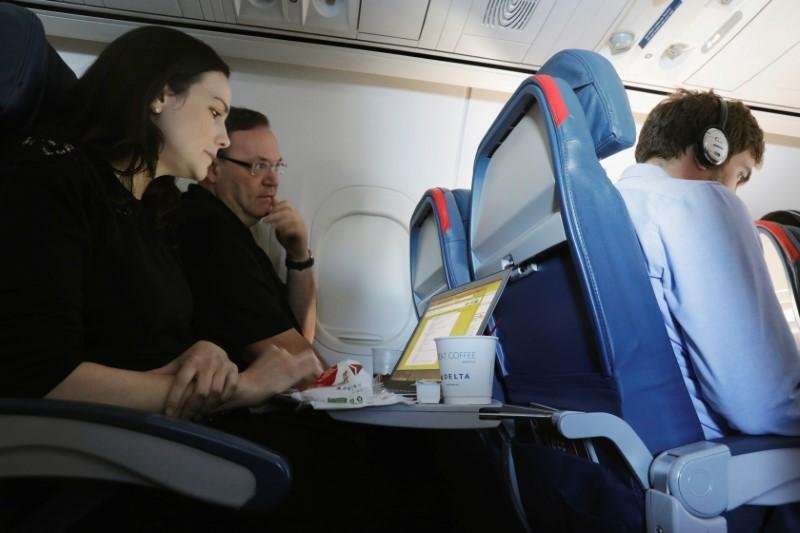A woman uses her laptop on a flight out of John F. Kennedy (JFK) International Airport in New York, U.S., May 26, 2017. Picture taken May 26, 2017.
WASHINGTON (Reuters) - U.S. aviation authorities were ordered back to the drawing board on Friday to solve what a federal appeals judge called "The Case of the Incredible Shrinking Airline Seat."
Judge Patricia Millett told the Federal Aviation Administration to take another look at an advocacy group's assertion that shrinking airline seats are imperiling passenger safety.
The judge rejected the FAA's argument that seat size was unimportant to getting off the plane in an emergency.
"That makes no sense," she wrote for the three-judge panel, likening the rationale to doing "a study on tooth decay that only recorded participants’ sugar consumption" but did not look at brushing and flossing.
All three judges on the U.S. Court of Appeals for the District of Columbia Circuit agreed the FAA must conduct a new review of the request for regulations setting a minimum airline seat size, but Judge Judith Rogers dissented from part of the court's rationale.
Airline seats have steadily decreased in size over the last several decades. Economy-class seat pitch has decreased from an average of 35 inches (89 cm) in the 1970s to 31 inches (79 cm), and in some airplanes to 28 inches (71 cm).
Average seat width has narrowed from about 18 inches (46 cm)to 16.5 inches (42 cm) over the last decade.
Critics accuse the airlines of being more interested in profit than passenger health and safety.
FAA spokesman Greg Martin wrote in an e-mail the agency "does consider seat pitch in testing and assessing the safe evacuation of commercial, passenger aircraft. We are studying the ruling carefully and any potential actions we may take to address the court’s findings."
An airline trade group declined to comment.
Seat pitch is the distance from one seat to the same spot on the one in front or behind.
The ruling was limited to the question of whether smaller seats and larger passengers could have an impact on emergency egress. It did not require the FAA to look at the impact on comfort and health.
A U.S. House of Representatives bill under consideration would require the FAA to set minimum seat sizes on U.S. airlines and a minimum distance between rows to "protect the safety and health of airline passengers."
Last month American Airlines Group Inc said it would reduce leg room by one inch to 30 inches instead of two as originally planned on some seats in its Boeing 737 MAX jets.
United Airlines President Scott Kirby told a congressional hearing in May the airline had yet to decide whether to cut pitch to 29 inches in some seats. Nearly all United seats have at least 31 inches of pitch.

50calPeephole on July 30th, 2017 at 18:13 UTC »
Average width of a adult male's shoulders is 18"...
MotherfuckingMonster on July 30th, 2017 at 17:24 UTC »
Did nobody read this shit? They're investigating if cramped seats impact egress in an emergency. Nobody's asking why airlines made seats smaller in the first place.
GenderlessAutomaton on July 30th, 2017 at 17:24 UTC »
I am 6' 1" and when I sit normally in a economy class Delta seat my knees touch the seat in front of me. I cannot slouch, I cannot cross my legs, I cannot touch my feet, I cannot be comfortable in any way more than 10 minutes and I certainly can't sleep. 15 hour trans-pacific flights would be like sitting in one of those wooden Medieval punishment boxes if I couldn't get up and do yoga stretches in front of 60 people every so often.